Solving linear equations -> elimination
Elimination in Algebra
Elimination is a method used to solve systems of linear equations by adding or subtracting the equations to eliminate one of the variables. This method is often used when the coefficients of one of the variables in the two equations are additive inverses of each other (i.e., one is the negative of the other).
Steps for Using the Elimination Method
- Write down the two equations of the system.
- Multiply one or both equations by constants if necessary to make the coefficients of one of the variables additive inverses.
- Add or subtract the equations to eliminate one of the variables.
- Solve for the remaining variable.
- Substitute the value found in step 4 into one of the original equations to solve for the other variable.
Example
Solve the system of equations using the elimination method:
Equation 1: 2x + 3y = 11
Equation 2: 3x - 2y = 2
- Multiply Equation 1 by 3 and Equation 2 by 2 to make the coefficients of y additive inverses:
- Subtract Equation 2 from Equation 1 to eliminate the variable x:
- (6x + 9y) - (6x - 4y) = 33 - 4
- 13y = 29
- Solve for y:
- y = 29/13
- Substitute y back into one of the original equations to solve for x:
- 2x + 3(29/13) = 11
- 2x + 87/13 = 11
- 2x = 143/13 - 87/13
- 2x = 56/13
- x = 56/26
Study Guide
When using the elimination method to solve a system of linear equations, it's important to follow these steps:
- Identify the coefficients of the variables in each equation.
- Determine which variable to eliminate by adding or subtracting the equations.
- Multiply one or both equations by constants to make the coefficients of the chosen variable additive inverses.
- Add or subtract the equations to eliminate the chosen variable.
- Solve for the remaining variable.
- Substitute the value found in step 5 into one of the original equations to solve for the other variable.
It's also important to practice solving different systems of equations using the elimination method to become proficient in this technique.
.◂Math Worksheets and Study Guides Eighth Grade. Solving linear equations
Study Guide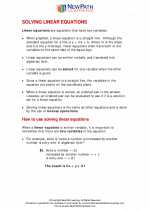 Solving linear equations
Solving linear equations  Worksheet/Answer key
Worksheet/Answer key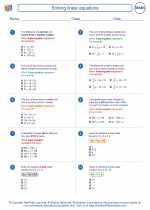 Solving linear equations
Solving linear equations  Worksheet/Answer key
Worksheet/Answer key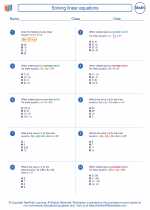 Solving linear equations
Solving linear equations  Worksheet/Answer key
Worksheet/Answer key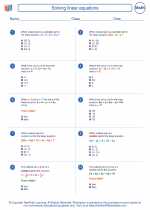 Solving linear equations
Solving linear equations  Worksheet/Answer key
Worksheet/Answer key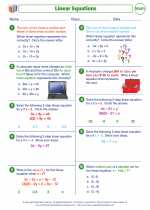 Solving linear equations
Solving linear equations  Worksheet/Answer key
Worksheet/Answer key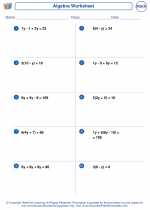 Solving linear equations
Solving linear equations 

 Worksheet/Answer key
Worksheet/Answer key
 Worksheet/Answer key
Worksheet/Answer key
 Worksheet/Answer key
Worksheet/Answer key
 Worksheet/Answer key
Worksheet/Answer key
 Worksheet/Answer key
Worksheet/Answer key

The resources above cover the following skills:
Algebra (NCTM)
Represent and analyze mathematical situations and structures using algebraic symbols.
Use symbolic algebra to represent situations and to solve problems, especially those that involve linear relationships.